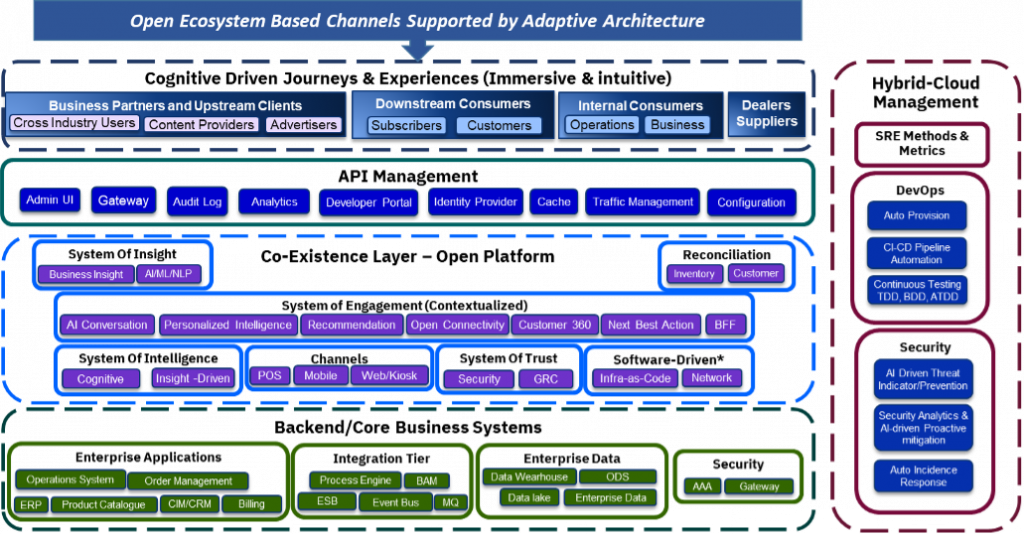.
Role of CIO In Blending Business & Technology
August 5, 2021 | Written by: Anil Paingankar and Atul Misra
Categorized: . | Digital Reinvention
Share this post:
In recent years we have seen exponential advancement in computing and storage, powered by intelligent and self-learning technologies. The technology evolution cycle and innovation bring in new opportunities as well as challenges for sustenance. The role of the CIO has become crucial in manoeuvring an organization through these waves of disruptive technology advancements [1]. We have observed our client’s businesses are trying to stay relevant and responsive in a dynamic and competitive marketplace.
Earlier business strategy built within the boardroom would drive the technology strategy and its adoption. In the current scenario, technology innovations are becoming the drivers for the transformation of business and operations models. To bring the right synergy, both, the business, and technology capability of an organization need to be agile, adaptive and must blend with each other. CIO’s becomes accountable for building an organization where business and technology blend, thereby seamlessly complementing their transition.
We present the ‘flex model’ that will enable CIOs to blend the business and technology capability for futureproofing their enterprise.
Adaptive Architecture of Flex Model
The flex model is an adaptive architecture that tunes to the business model transition within a short time frame. Agility is achieved across the architecture tiers like cognitive driven front-end, API (open/private), application, OS, data/information, integration, development-deployment support as well as flexible hosting infrastructure.
Transforming the current state architecture to the stated flex model comes with challenges,
Identify Change Strategy: To build a blended business and technology capability using flex model, it is necessary to have a deep knowledge of the current state, its agility quotient to transform, and malleability to adapt. It is, therefore, necessary to have an accurate assessment report of the current state to derive the change strategy.
Building the Right Business Ecosystem: Businesses following pipeline-based models are now transforming to be ecosystem-based. This requires,
- Building the right ecosystems of partners, those who complement each other and succeed together synergistically.
- Identify the right drivers, e.g. aggregated values, non-conflicting, with common win theme
- Shared success and common growth strategy
On-going business and operations achieve the expected business outcome, modernizing to an adaptive architecture of flex model need careful execution with the non-disruptive approach. This can be achieved by incremental transition and continuous monitoring of the transformation journey. A cautious transition to modernization and continuous assessment of business outcomes manages any transformation derailment and control over the investment.
Also, in addition to technology disruption, there are impacts on governance, data/information, people and process, and must be addressed sensitively. It is observed, that managing the transformation of the core business applications, and application in transition, and their interworking, is a complex proposition.
We, therefore, have developed a code pattern called the coexistence layer that doubles up to be a digital decoupling layer [2].
The Coexistence Layer
The coexistence layer plays a crucial role to achieve the flex model by enabling the transition to an adaptive architecture without unacceptable business and operations disruption. It addresses and enables key components of the transformation:
- Application refactoring, rearchitect/rewrite (strangler pattern)
- Digital decoupling layer, building new cloud-native services without disrupting core business applications and data
- Enterprise data governance layer (available for internal and external consumption)
- Service mash-up of internal and external services, like social, partner/supplier business functions, cloud services, AI/ML services
- As system of engagement for building business-context driven services
- As reconciliation layer, system of intelligence, system of trust (security and regulatory compliance), and system of insight
- It forms a business and technology sandbox for innovation, where business capabilities can be built within a short period and also rolled back, if unsuccessful.
- It also conforms to principles of “build-once-deploy-anything-anywhere”
- This approach can also be utilized for building a data governance layer for the enterprise.
This code pattern enables incremental transition that could continuously assess and monitor custom business success criteria. This helps to build the stakeholders’ confidence by making the transformation journey non-disruptive and outcome-based. The coexistence layer provides the right control to the CIO to manage the modernization to a flex model.
Open platform architecture is used to develop coexistence layer code patterns and as the platform matures with added functions and features, CIO’s can build the right blending of business and technology. Figure 1 illustrates the coexistence layer architecture (representation only, not exhaustive).

Transformation is like a living organism
CIO must correlate the transformation as a living organism that can react to stimuli, reproduce, grow, adapt, and maintain synchronization between adaptive business and technology. An incremental transition with continuous monitoring of business value and ROI instils stakeholder confidence and ensures business sustainability. Remember, in the current New World, technology drives the business model and must be blended.
We have observed that the success of an enterprise depends on a CIO’s participation in business strategy. They need to have insights into business impact from emerging technology, market dynamics, study competitive (known and unknown) landscape, and contribute to business model innovation inspired through technology. This must be backed by a matured Enterprise Architecture Practice that is powered by agile governance and with a start-up mindset[3]. Each business capability must be driven by squads that understand how business, and technology blend together [4].
With Technology driving business innovation, a transformation journey to blend them, it is expected to be intricate and meticulous. However, with the right ecosystem of technology and business partners, it is an exciting journey to tread through [5].
Connect with Dr. Anil M Paingankar LinkedIn
Connect with Mr. Atul Misra LinkedIn
References:
[1] https://www.ibm.com/thought-leadership/institute-business-value/c-suite-study/ceo
[2] Modernize a legacy application with digital decoupling – IBM Developer
[3] https://www.ibm.com/in-en/cloud/application-modernization
[4] https://www.ibm.com/in-en/garage
[5] https://www.ibm.com/in-en/services/cloud/modernize-applications

Insurance Company Brings Predictability into Sales Processes with AI
Generally speaking, sales drives everything else in the business – so, it's a no-brainer that the ability to accurately predict sales is very important for any business. It helps companies better predict and plan for demand throughout the year and enables executives to make wiser business decisions.
Never miss an incident with an application-centric AIOps platform
Applications are bound to face occasional outages and performance issues, making the job of IT Ops all the more critical. Here is where AIOps simplifies the resolution of issues, even proactively, before it leads to a loss in revenue or customers.
Logistics Operations Management ERP on AWS Cloud
Logistics operations is an essential part of the supply chain and refers to the process of moving finished goods, starting from the manufacturer, and moving to the end user.



